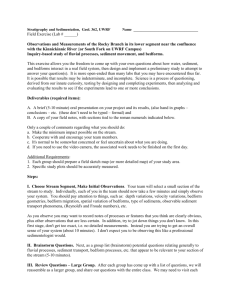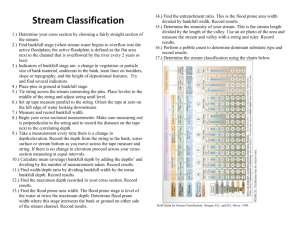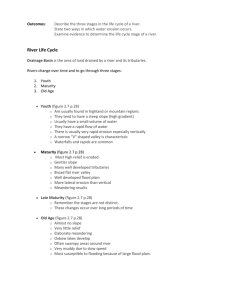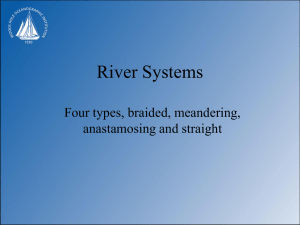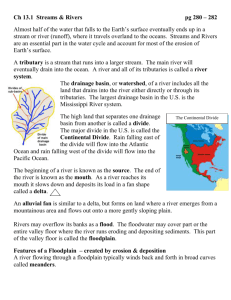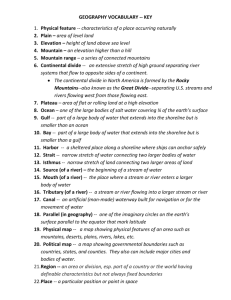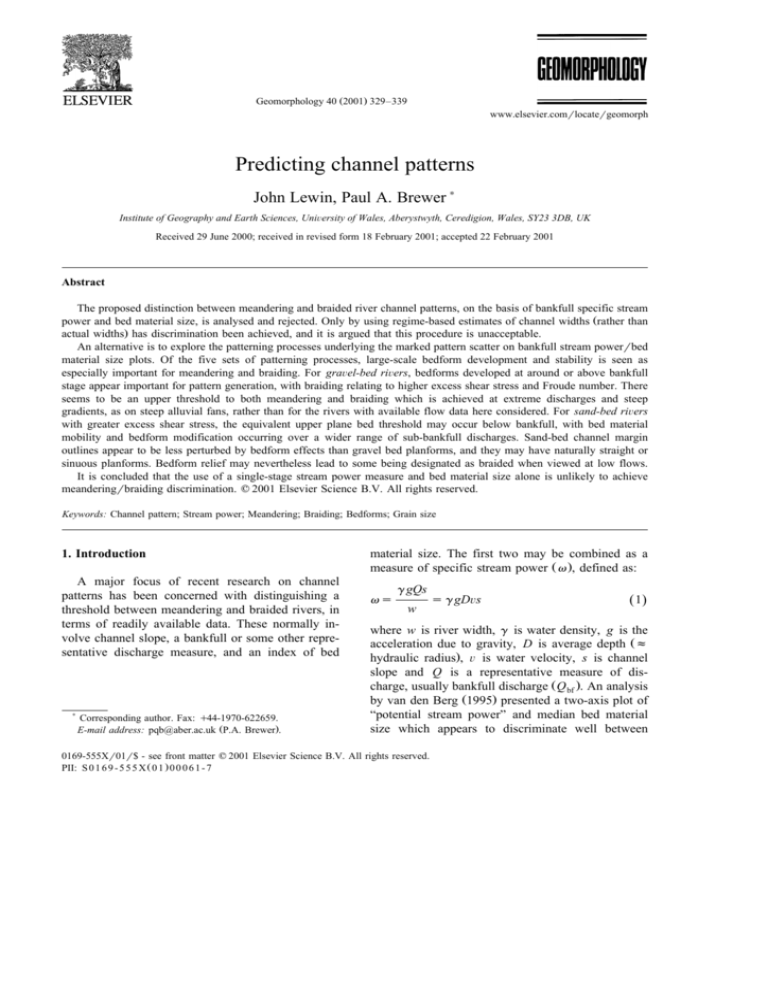
Geomorphology 40 Ž2001. 329–339
www.elsevier.comrlocatergeomorph
Predicting channel patterns
John Lewin, Paul A. Brewer )
Institute of Geography and Earth Sciences, UniÕersity of Wales, Aberystwyth, Ceredigion, Wales, SY23 3DB, UK
Received 29 June 2000; received in revised form 18 February 2001; accepted 22 February 2001
Abstract
The proposed distinction between meandering and braided river channel patterns, on the basis of bankfull specific stream
power and bed material size, is analysed and rejected. Only by using regime-based estimates of channel widths Žrather than
actual widths. has discrimination been achieved, and it is argued that this procedure is unacceptable.
An alternative is to explore the patterning processes underlying the marked pattern scatter on bankfull stream powerrbed
material size plots. Of the five sets of patterning processes, large-scale bedform development and stability is seen as
especially important for meandering and braiding. For graÕel-bed riÕers, bedforms developed at around or above bankfull
stage appear important for pattern generation, with braiding relating to higher excess shear stress and Froude number. There
seems to be an upper threshold to both meandering and braiding which is achieved at extreme discharges and steep
gradients, as on steep alluvial fans, rather than for the rivers with available flow data here considered. For sand-bed riÕers
with greater excess shear stress, the equivalent upper plane bed threshold may occur below bankfull, with bed material
mobility and bedform modification occurring over a wider range of sub-bankfull discharges. Sand-bed channel margin
outlines appear to be less perturbed by bedform effects than gravel bed planforms, and they may have naturally straight or
sinuous planforms. Bedform relief may nevertheless lead to some being designated as braided when viewed at low flows.
It is concluded that the use of a single-stage stream power measure and bed material size alone is unlikely to achieve
meanderingrbraiding discrimination. q 2001 Elsevier Science B.V. All rights reserved.
Keywords: Channel pattern; Stream power; Meandering; Braiding; Bedforms; Grain size
1. Introduction
A major focus of recent research on channel
patterns has been concerned with distinguishing a
threshold between meandering and braided rivers, in
terms of readily available data. These normally involve channel slope, a bankfull or some other representative discharge measure, and an index of bed
)
Corresponding author. Fax: q44-1970-622659.
E-mail address: pqb@aber.ac.uk ŽP.A. Brewer..
material size. The first two may be combined as a
measure of specific stream power Ž v ., defined as:
vs
g gQs
w
s g gDÕs
Ž 1.
where w is river width, g is water density, g is the
acceleration due to gravity, D is average depth Žf
hydraulic radius., Õ is water velocity, s is channel
slope and Q is a representative measure of discharge, usually bankfull discharge Ž Q bf .. An analysis
by van den Berg Ž1995. presented a two-axis plot of
Apotential stream powerB and median bed material
size which appears to discriminate well between
0169-555Xr01r$ - see front matter q 2001 Elsevier Science B.V. All rights reserved.
PII: S 0 1 6 9 - 5 5 5 X Ž 0 1 . 0 0 0 6 1 - 7
330
J. Lewin, P.A. Brewerr Geomorphology 40 (2001) 329–339
braided and meandering streams ŽFig. 1b.. His relationship has been widely cited; as Thorne Ž1997. has
written, Aa discriminate function of this type may
well represent the logical endpoint of a line of
investigation into the meanderrbraiding threshold
begun by Lane and by Leopold and Wolman nearly
40 years agoB. The whole area of study has been
usefully and comprehensively reviewed by Ferguson
Ž1987..
However, we do have strong reservations about
both van den Berg’s analysis and this approach in
general. Raw specific stream powerrgrain size relationships using the van den Berg data are presented
in Fig. 1a. To these he reasonably applies an adjustment factor converting the channel slope of sinuous
rivers to valley slope. He then rejects the use of
obserÕed widths of both braided and meandering
streams and derives them ‘independently’ of pattern
Fig. 1. Braided and meandering rivers in relation to bankfull specific stream power using the methods and data of van den Berg Ž1995.; Ža.
for actual specific stream power, and Žb. for ApotentialB specific stream power. There are fewer data points in Ža. since channel width
values, required for specific stream power calculation, are not available for all the original data sources.
J. Lewin, P.A. Brewerr Geomorphology 40 (2001) 329–339
using two separate regime equations Žone for sandbed and the other for gravel-bed rivers. of the form:
w s aQ bbf
Ž 2.
It is by using these width estimates in plots of
potential specific stream power that discrimination
between the fields occupied by meandering and
331
braided channel patterns is achieved ŽFig. 1b.. It has
not always been appreciated that adjusted ‘potential’
power is required to achieve this discrimination Žsee,
for example, Knighton Ž1998., pp. 210–211..
The effect of applying the two regime-based width
estimates on meandering and braided rivers, rather
than using actual widths, is illustrated in Fig. 2. The
Fig. 2. The adjustments effect produced in van den Berg’s potential stream power method by applying his two regime-based estimating
equations to sand and gravel bed rivers; Ža. for meandering rivers, and Žb. for braided channels. Triangles and solid circles represent the
adjusted stream power using regime-based widths, and are compared to stream powers using actual widths Žhorizontal bars..
332
J. Lewin, P.A. Brewerr Geomorphology 40 (2001) 329–339
meandering data set is slightly modified ŽFig. 2a.,
improving the correlation between stream power and
grain size for this pattern type. But the effect on
braided channels is to raise many specific stream
powers considerably ŽFig. 2b., and it is this above all
which leads to the apparent discriminatory value of
‘potential’ Žusing adjusted widths. rather than the
actual specific stream power Žcompare Fig. 1a and
b..
Why should this be so? Van den Berg takes the
constant a of Eq. Ž2. to be 3, citing Ferguson Ž1981..
Ferguson’s analysis used data for British rivers, including those of Nixon Ž1959., Charlton et al. Ž1978.,
and others. But these data for Žlargely. gravel-bed
rivers are for non-braided channels, in other words
pattern-biased. If such relations are used for gravelbed channels in general, they are likely to underestimate braided-channel bed widths, thus effectively
enhancing their apparent specific stream power by
decreasing the denominator in Eq. Ž1.. Hydraulic
geometry relationships for gravel-bed rivers usually
exclude or give special consideration to braiding
Že.g. Parker, 1979; Chang, 1980; Hey and Thorne,
1986.. Flume studies of braided channels by Ashmore Ž1991. give a higher constant and lower exponent than is assumed by van den Berg Ž1995.:
w s 12.76Q 0 .45
Ž 3.
Field data for braided stream hydraulic geometry
have also been presented by Mosley Ž1983., again
with higher constants and lower exponents than those
used by van den Berg.
Width is of course only one of several hydraulic
variables which may mutually adjust, and relationships with discharge are not likely to work well with
complex channel patterns Žsee Ferguson and Ashworth, 1991.. We therefore do not agree that this
procedure for ‘potential’ specific stream power is a
valid one: it achieves its pattern-discriminating results only by applying an unjustifiable regime-based
width estimating relation, especially through a stream
power adjustment to braided patterns, for which the
regime relations used are inappropriate.
We also have a second objection. Quite understandably, many researchers’ objectives have been
underlain, consciously or otherwise, by a desire to
achieve a relatively simple discrimination for practi-
cal purposes so that engineers, palaeohydrologists
and others may anticipate potential pattern transformation on a simple and comprehensive basis across
the whole range of grain sizes using readily available
data. However laudable the objective, we believe the
approach does not involve hydraulic considerations
in an appropriate manner, and it disguises rather than
exposes the patterning processes which underpin the
channel pattern continuum.
2. Patterning processes
There are five basic groups of channel patterning
processes in alluvial channels:
1. Channelised flow leading to ‘streamlining’ and
sinuosity development phenomena—as in meander development in single channels or on
braided reaches, and the evolving, often multicurved and facetted outlines of river islands.
2. Bedform development, which can initiate both
meandering and braiding, or modify channel
pattern especially where large-scale bedforms
become stalled and stable relative to bank recession.
3. Channel junction and bifurcation effects.
4. Bank breaching, as in chute cutoffs, crevasses
and avulsions.
5. Dissection phenomena, in which prior Žgenerally high-flow. forms are subsequently dismembered or possibly infilled and obscured by
activities which include headcut recession and
local development of drainage networks within
alluvial deposits.
These processes may occur in combination to be
more or less important in any specific river environment. Thus, the initiation of braiding may involve an
interrelationship between channels and large-scale
bedforms, with braided patterns then being ‘maintained’ and modified by streamlining, junctionrbifurcation effects, breaching and dissection. A distinction may be made for meandering rivers in which
bends are ‘forced’ by bar development or ‘free’ with
bends developing sinuous patterns by bank erosion
J. Lewin, P.A. Brewerr Geomorphology 40 (2001) 329–339
accompanied by point sedimentation which essentially follows channel sinuosity evolution ŽIkeda,
1989..
Channels, and their dimensions, may reasonably
be related to ‘formative’ bankfull discharges, though
with some provisos. For example, bank strength may
be independently significant including cohesive effects by non-bed sediments and vegetation ŽHey and
Thorne, 1986; Millar, 2000.. The recurrence interval
of bankfull discharges may vary ŽWilliams, 1978.,
and extreme events may also require consideration
since they can produce large channels that may
revert to smaller ones over a period of years Žfor
review and discussion, see Lewin 1989..
Large-scale bedforms are particularly important
determinants of channel pattern: they may develop
with excess shear stress above the threshold for
sediment transport, but below the dune-plane bed
transition. The situation is also complicated by the
possible existence of upper regime bedforms and of
large-scale rhomboidal bedform swarms in natural
rivers which do not appear to distort the overall river
bank outline ŽCollinson, 1970; Crowley, 1983.. Ein-
333
stein and Shen Ž1964. noted the existence of latticelike patterns and diagonal ‘bars’ developed at high
Froude numbers Žnot necessarily the same as gravelbed diagonal bars which develop at lower Froude
numbers.. Others are less inclined to recognise distinctive upper-stage dune regimes ŽAshley, 1990..
In Shields dimensionless shear stress Ž u . terms
for coarser sediment, transport is achieved at values
of around u f 0.06, whilst according to Carling
Ž1999. the dune-plane bed transition is at u f 0.25.
Parker Ž1976. and a number of other researchers
have suggested that within the sediment transport
and upper plane bed limits, dunes develop at higher
Froude ŽFr. numbers. Limits under field conditions
are of course complicated by the existence of sediment size mixtures, armouring and bedforms, as field
research has made clear Žsee Church, 1978; Komar,
1996.. Though the applied force is usually expressed
in terms of shear stress, it is possible to use stream
power, in the manner of Bagnold Ž1980..
It has to be appreciated, however, that a given
stream power can be achieved by different combinations of hydraulic variables. Fig. 3 plots a 100 W
Fig. 3. The specific stream power surface for v s 100 W my2 , in relation to slope, velocity and depth, showing also lines of equal Froude
number.
334
J. Lewin, P.A. Brewerr Geomorphology 40 (2001) 329–339
my2 specific stream power surface within the value
limits for width, depth and velocity in the dataset
used here. Also plotted are Froude number contours.
In practice, real streams can only occupy certain
locations on such constant stream power surfaces
given the actual combinations of depth and gradient
available in terrestrial environments and the flow
resistance constraints on velocity as incorporated
into the well-known Darcy–Weisbach or Manning
resistance equations. But the point to note is that a
single stream power value may reflect a variety of
hydraulic conditions. Similarly, bankfull flows covering a range of incident stream powers Žin our
dataset 1 - v ) 1000. include a considerable range
of mean Froude numbers, depths and velocities at
bankfull as is shown in Fig. 4.
Finally, concerning bedforms, it should be stressed
that there is a good body of laboratory data for
small-scale bedforms in sandy sediment. This has
most usefully been brought together by Southard and
Boguchwal Ž1990., who show, incidentally, that plane
beds develop well below a Froude number of 0.84,
with bedform domain boundaries not exactly paralleling Froude number values. The laboratory data in
general are derived from steep-gradient, shallow
depth flumes, corrected for temperature effects on
viscosity. Using these data for deeper-water gentlergradient flows requires caution, and there are few
data on larger-scale field bedforms. For field bedforms in coarser materials this is equally the case,
and it is much more difficult to obtain hydraulic
parameters Žthough see Dinehart, 1989, 1992.. Carling Ž1999. has, however, usefully collated and analysed the evidence for gravel dunes available to date.
Despite the scarcity of field hydraulic data relating to their formation, large-scale bedforms and their
development and persistence are likely to be crucial
patterning determinants in the distinction between
dominantly braided and meandering rivers. This is
unlikely to relate in a straightforward way to bankfull stream power alone. It may alternatively be
possible to suggest some interpretations of what lies
behind stream powerrgrain sizerchannel pattern relationships, given consideration of factors in bedform
development as discussed above.
Fig. 5 provides a plot of ‘raw’ specific stream
power at bankfull discharge, grain size and channel
patterning data using a larger data set than that used
by van den Berg Ž1995.. We have included 113
additional data points from Chitale Ž1973; 33 sites.,
Ferguson and Ashworth Ž1991; 1 site., Hey and
Thorne Ž1986; 44 sites. and Kellerhals et al. Ž1972;
35 sites.; all studies which van den Berg used, but
from which he selected only parts of the published
dataset. The scatter in channel patterns is even more
apparent, with many sandy meandering channels at
Fig. 4. Channel pattern, flow depth, velocity and Froude number Ž F . for the enlarged river data set Žsee text..
J. Lewin, P.A. Brewerr Geomorphology 40 (2001) 329–339
335
Fig. 5. Unadjusted specific stream power and bed median grain size for the enlarged data set Žsee text. and showing rivers reported as
braided, meandering and straight.
relatively high specific stream powers, and considerable overlap between meandering and braided
gravel-bed river occurrence fields.
Fig. 6 plots channel pattern in relation to mean
bed shear stress at bankfull and grain size. Such plots
have commonly been used in considering sediment
transport and dune development, but not channel
pattern. Here it may be helpful to consider sand and
gravel-bed rivers separately. In dimensionless shear
stress terms, most of the non-straight graÕel-bed
riÕer data plot within 0.06 - v ) 0.25 limits, with a
tendency for braids to develop at higher Froude
numbers ŽTable 1. as might be anticipated following
Parker Ž1976. and others. Some patterns appear to
have been achieved below the assumed limit for
sediment transport. It has to be borne in mind that
the data used are mean reach data, and this does not
preclude particular channel locations within a reach
Fig. 6. Channel pattern, mean bed shear stress and median grain size. Shields dimensionless shear stress values Ž u . of 0.25 and 0.06 are also
shown.
J. Lewin, P.A. Brewerr Geomorphology 40 (2001) 329–339
336
Table 1
Bankfull Froude numbers from the van den Berg data for rivers
where surveyed channel dimensions are available
Bankfull Froude number
- 0.40 0.40–0.59 0.60–0.79 0.80–0.99 Total
Sand-bed
braiding
Gravel-bed
braiding
Gravel-bed
meandering
Sand-bed
meandering
Total
4
2
0
0
6
4
10
12
2
28
14
0
0
0
14
20
26
15
0
61
42
38
27
2
109
from having higher shear stresses and thus erosionalrdepositional activity. Alternatively, patterning may relate to shear stress achieved at higher than
bankfull stage.
Straight gravel-bed channels, which have been
rather neglected in the literature, can relate to high
and low shear stresses and stream powers. It may be
that high stream power ones naturally develop under
plane bed conditions when they are undiverted by
near-stationary bedforms. Alluvial fan rivers, which
may branch but remain relatively straight, could
provide helpful information in this regard though
they are not usually incorporated into channel pat-
terning analyses. Although not all researchers have
done so, it is interesting that Blair and McPherson
Ž1994. in effect restrict their definition of fans to
high-gradient features Žgreater than about 18.. They
note a common absence of either braiding or meandering in the construction of fan sedimentary bodies
and the prevalence of sheetflood or debris flow
deposits.
Sand-bed riÕers exhibit considerable scatter at
bankfull conditions on the shear stressrgrain size
plot. When data are alternatively plotted in a
depthrvelocity field in the manner of Southard and
Boguchwal Ž1990., but extending Žat some risk. their
laboratory bedform-type boundaries to greater depths
and velocities, it seems likely that these rivers could
be in the upper plane bed domain ŽFig. 7.. Physical
modelling of highly sinuous meandering has proved
notoriously difficult, though it is perhaps not surprising that Froude-scale modelling at higher Froude
numbers, or unscaled but steep-gradient sand tray
experiments, produce ‘gravel like’ channels rather
than field forms at the lower Froude numbers suggested for larger sand-bed meanders ŽFig. 4.. For
bedforms, the laboratory data and boundaries relate
to shallow Žless than 1 m. flows under accurately
determined conditions, as previously discussed, and
these strictly relate to small-scale bedforms. Nevertheless, it does not seem to have been previously
Fig. 7. Bankfull depth, velocity and channel pattern for sand-bed rivers. Also shown are Froude numbers of 1.0 and 0.84, and the upper
regime plane bed limit lines Župper regime to the right. for grain sizes of 0.10–0.14 mm and 0.64 mm for laboratory experimental data from
Southard and Boguchwal Ž1990., but extended to greater depths than those reported in their experiments.
J. Lewin, P.A. Brewerr Geomorphology 40 (2001) 329–339
appreciated that there may be an upper threshold for
larger sub-critical-flow bedforms and thus braiding
in relation to dune development for sandy rivers, in
addition to those in coarser sediments as just discussed. For sand, this could be achieved at less than
bankfull stage. Sand-bed rivers are also often well
above the threshold for sediment motion at bankfull
stage, and this confirms the point that sandy bedforms can be generated at intermediate flow stages,
possibly being eliminated as stages rise to bankfull,
and reworked as they fall to lower ones still above
the threshold level for sediment transport. At bankfull, the sand-bed dataset used here is dominated by
rivers described as meandering, with no real distinction in Froude number between meandering and
braided types ŽTable 1.. But overall, the point to note
is that the channel outline and channel bedforms may
relate to different river stages. Channel-forming and
dune-forming conditions may be differentially
achieved for gravel and sand-bed rivers over the
field range of incident stream powers. For dune
formation, Fig. 6 implies that terrestrial conditions
allow dune formation in fine sediments at well below
bankfull, but possibly above bankfull flows are required for the coarsest materials which can only
move in extreme events when channel forms are also
determined.
There are also implications for meander development. In the field, larger-scale bedform generation in
gravels at high flow may initiate the development of
channel sinuosity Ževentually at greater wavelengths
than the bedforms. around stalled bars ŽLewin, 1976..
This has been explained in terms of two-stage barbend models, for example by Seminara and Tubino
Ž1989.. But field investigations of sand-bed channels
have proved somewhat disappointing in this regard.
Welford Ž1994. observed bar development in six
floods, forming on the descending limb of the flood
hydrograph, but eradicated at lower flows in all but
one bar. Field sand-bed meander initiation may not
in practice be related to persistent bend forcing
high-flow bedforms, and it is possible to model
meander generation physically ŽSchumm et al., 1987;
Fig. 5.2b. or numerically ŽHoward, 1996. without
them in a manner which appears realistically to
replicate the high-sinuosity forms achieved in some
finer-sediment environments in the field. Sandy bedforms may have neither the appropriate size nor the
337
persistent stability to influence channel outlines. Field
comparison of gravel- and sand-bed meander forms
shows that the former have multi-arc bends which
quite commonly are diversified with bedforms
achieved at high flows Žand extreme floods. and
stalled thereafter; the latter are more normally characterised by smoother bends and develop ‘platform’
point bars which follow the evolution of planforms
and which are a result rather than an initiating cause
of meandering Žsee also Ikeda, 1989.. In fact such
‘unforced- bend’ sedimentation and erosion is important in many channel patterns in single and multithread courses, which have lunate growth increments
Žon the inside of meander bends. or streamlined
islands Žwith pointed ends and convex, concave and
convexo-concave sides. which are quite unlike larger
linguoid depositional bedforms which may, in some
cases, have played an earlier core role in ‘forced’
planform pattern initiation.
3. Conclusions
We believe that van den Berg’s Ž1995. analysis of
‘potential’ bankfull stream power and grain size is
invalid, and that it obscures the complexity of processes which underlie the patterning of river planforms. When the vital factor of bedform development is taken into account, the following suggestions
may be made with reference to the apparent scatter
of channel patterns within the raw stream
powerrgrain size data plot.
Ž1. Large-scale dune development Žf transverse
bar. takes place alongside channel development at
around bankfull stage in gravel bed rivers, below the
dune-plane bed transition and broadly but not precisely in relation to Froude number. Available channel width may affect the number of braids ŽParker
1976.. There are upper thresholds to braiding and
meandering as may be observed in extreme flows
and the steepest gradients Žas in alluvial fans., but
not generally in the dataset used here.
Ž2. Sand-bed braiding may take place at intermediate stages, not necessarily at bankfull when beds
can already be in an upper plane bed regime, and so
also possibly above an upper threshold for dune
development and braiding. Dunes may also be
formed, reworked and reduced over a wide range of
338
J. Lewin, P.A. Brewerr Geomorphology 40 (2001) 329–339
flows. Whilst such dunes may diversify exposed
channel beds, their scale or persistence makes them
less significant in their effect on the outline of
bankfull channels than in the case of gravel-bed
rivers.
Ž3. Processes of meander initiation may differ as
between sand-bed and gravel-bed meanders in field
conditions. The latter may be initiated and their
planforms recurrently diversified by large and extreme-event stalled duneforms; the simpler planforms of sand-bed meanders in the field may be
initiated by down-channel wave propagation without
bedform triggering, as some models have suggested.
Ž4. Given the very limited amount of direct observational data on bedform development in natural
rivers Žincluding the fact that there is little information concerning even river stage and bedform generation., it is for the present inevitable that these suggestions require further field validation.
Predicting the incidence of the other overlapping
patterning processes listed earlier on a reliable basis
is also far from straightforward. For example, the
bank-breaching process is important in maintaining
both anastomosed and braided channel patterns. The
process Žincluding the variants of chute cut-off,
crevassing and avulsion. appears to depend on successful combinations of: local or general channel
sediment build-up, momentum effects involving
channel curvature and gradient, greater than channel
full discharges, bank resistance and profile irregularity, and finally out-of channel topography and resistance which determine the short or long course subsequently followed by the new breaching channel.
These factors are not resolvable in terms of in-channel grain size and bed shear stress or bankfull stream
power. Overall, we believe that it is better to consider thresholds and process domains within each
group of patterning process rather than to seek a
simple across-the-board discrimination of pattern
types on the basis of bankfull specific stream power
and bed material size alone.
References
Ashley, G.M., 1990. Classification of large-scale subaqueous bedforms: a new look at an old problem. Journal of Sedimentary
Petrology 60, 160–172.
Ashmore, P., 1991. Channel morphology and bed load pulses in
braided, gravel bed streams. Geografiska Annaler 73A, 37–52.
Bagnold, R.A., 1980. An empirical correlation of bedload transport rates in flumes and natural rivers. Proceedings of the
Royal Society of London 372A, 453–473.
Blair, T.C., McPherson, T.G., 1994. Alluvial fans and their natural
distinction from rivers based on morphology, hydraulic processes, sedimentary processes and facies assemblages. Journal
of Sedimentary Research, Section A: Sedimentary Petrology
and Processes 64, 450–489.
Carling, P.A., 1999. Subaqueous gravel dunes. Journal of Sedimentary Research 69, 534–545.
Chang, H.H., 1980. Geometry of gravel streams. Journal of the
Hydraulics Division, ASCE 106 ŽHY9., 1443–1456.
Charlton, F.G., Brown, P.M., Benson, R.W., 1978 .The hydraulic
geometry of some gravel bed rivers in Britain. Report IT180,
Hydraulics Research station, Wallingford, England.
Chitale, S.V., 1973. Theories and relationships of river channel
patterns. Journal of Hydrology 19, 285–308.
Church, M., 1978. Palaeohydrological reconstructions from a
Holocene valley fill. In: Miall, A.D. ŽEd.., Fluvial Sedimentology. Canadian Society of Petroleum Geologists, Calgary, pp.
743–772.
Collinson, J.D., 1970. Bedforms of the Tana River, Norway.
Geografiska Annaler 52A, 31–56.
Crowley, K.D., 1983. Large-scale bed configurations Žmacroforms., Platte River Basin, Colorado and Nebraska: primary
structures and formative processes. Geological Society of
America Bulletin 94, 117–133.
Dinehart, R.L., 1989. Dune migration in a steep, coarse bedded
stream. Water Resources Research 25, 911–923.
Dinehart, R.L., 1992. Evolution of coarse gravel bed forms: field
measurement at flood stage. Water Resources Research 28,
2667–2689.
Einstein, H.A., Shen, H.W., 1964. A study of meandering in
straight alluvial channels. Journal of Geophysical Research 69,
5239–5247.
Ferguson, R.I., 1981. Channel form and channel changes. In:
Lewin, J. ŽEd.., British Rivers. Allen and Unwin, London, pp.
90–125.
Ferguson, R.I., 1987. Hydraulic and sedimentary controls of channel pattern. In: Richards, K.S. ŽEd.., River Channels: Environment and Process. Blackwell, Oxford, pp. 129–158.
Ferguson, R.I., Ashworth, P., 1991. Slope induced changes in
channel character along a gravel-bed stream: the Allt Dubhaig,
Scotland. Earth Surface Processes and Landforms 16, 65–82.
Hey, R.D., Thorne, C.R., 1986. Stable channels with mobile
gravel beds. Journal of Hydraulic Engineering 112, 671–689.
Howard, A.D., 1996. Modelling channel evolution and floodplain
morphology. In: Anderson, M.G., Walling, D.E., Bates, P.D.
ŽEds.., Floodplain Processes. Wiley, Chichester, pp. 15–62.
Ikeda, H., 1989. Sedimentary controls on channel migration and
origin of point bars in sand-bedded meandering rivers. In:
Ikeda, S., Parker, G. ŽEds.., River Meandering. American
Geophysical Union, Water Research Monograph, vol. 12, pp.
51–68.
Kellerhals, R., Neill, C.R., Bray, D.I., 1972. Hydraulic and geo-
J. Lewin, P.A. Brewerr Geomorphology 40 (2001) 329–339
morphic characteristics of rivers in Alberta. Alberta Cooperative Research programme in Highway and River Engineering,
Report 72-1, 52 pp.
Knighton, A.D., 1998. Fluvial forms and processes. A New
Perspective. Arnold, London, 383 pp.
Komar, P.D., 1996. Entrainment of sediments from deposits of
mixed grain sizes and densities. In: Carling, P.A., Dawson,
M.R. ŽEds.., Advances in Fluvial Dynamics and Stratigraphy.
Wiley, Chichester, pp. 127–181.
Lewin, J., 1976. Initiation of bedforms and meanders in coarsegrained sediment. Geological Society of America Bulletin 87,
281–285.
Lewin, J., 1989. Floods in fluvial geomorphology. In: Carling,
P.A. ŽEd.., Floods: Hydrological, Sedimentological and Geomorphological Implications. Wiley, Chichester, pp. 265–284.
Millar, R.G., 2000. Influence of bank vegetation on alluvial
channel patterns. Water Resources Research 36, 1109–1118.
Mosley, M.P., 1983. Response of braided rivers to changing
discharge. Journal of Hydrology 22, 18–67.
Nixon, M., 1959. A study of bankfull discharge of the rivers in
England and Wales. Proceedings of the Institute of Civil
Engineers 12, 157–174.
Parker, G., 1976. On the cause and characteristic scales of meandering and braided rivers. Journal of Fluid Mechanics 76,
457–480.
339
Parker, G., 1979. Hydraulic geometry of active gravel rivers.
Journal of the Hydraulics Division, ASCE 105 ŽHY9., 1185–
1201.
Seminara, G., Tubino, M., 1989. Alternate bars and meandering:
free, forced and mixed interactions. In: Ikeda, S., Parker, G.
ŽEds.., River Meandering. American Geophysical Union, Water Research Monograph, vol. 12, pp. 267–320.
Schumm, S.A., Mosley, M.P., Weaver, W.E., 1987. Experimental
Fluvial Geomorphology. Wiley, New York.
Southard, J.B., Boguchwal, L.A., 1990. Bed configurations in
steady unidirectional water flows: Part 2. Synthesis of flume
data. Journal of Sedimentary Petrology 60, 658–679.
Thorne, C.R., 1997. Channel types and morphological classification. In: Thorne, C.R., Hey, R.D., Newson, M.D. ŽEds..,
Applied Fluvial Geomorphology for River Engineering and
Management. Wiley, Chichester, pp. 175–222.
Van den Berg, J.H., 1995. Prediction of alluvial channel patterns
of perennial rivers. Geomorphology 12, 259–279.
Welford, M.R., 1994. A field test of Tubino’s Ž1991. model of
alternate bar formation. Earth Surface Processes and Landforms 19, 287–297.
Williams, G.P., 1978. Bankfull discharge of rivers. Water Resources Research 14, 1141–1158.

